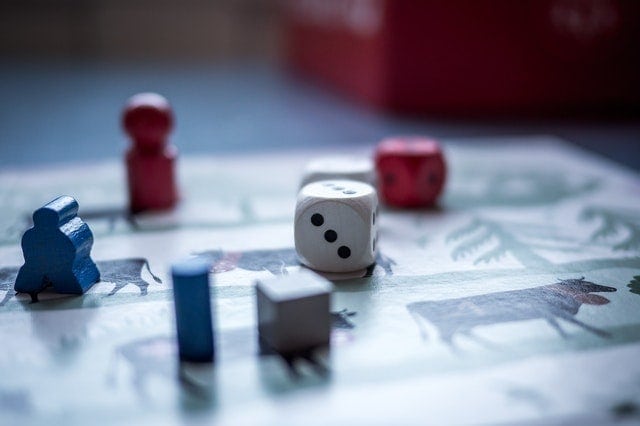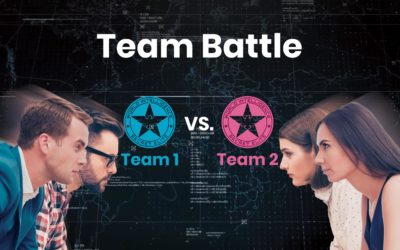Game-based Learning Solutions: Will it Bring Study-Game Balance to Students?

Games pique the interest of many students, especially if it’s visually appealing, tasks are challenging, and is not too academic. However, too much of it prevents the students from achieving certain learning outcomes, which forfeits the core objective of gamifying lessons. As Vlachopoulos & Makri (2017) had mentioned, most higher education institutions (HEIs) prepare students to become future professionals.
HEIs respond to the rapid evolution of technological applications, games, and simulations by integrating games in educational materials and teaching methods. However, will incorporating game-based learning solutions to learning materials bring a study-game balance to students?
In this blog post, we’ll share with you insights for the following key topics:
- What is game-based learning?
- Key features of a game-based learning
- Benefits of game-based learning in Various Contexts
- Considerations to take before integrating game-based learning solutions
What is game-based learning?
Game-based learning is an approach to learning where the material used reflects the game’s features, mechanics, and principles. The learning activities have game components embedded to promote student engagement and motivate users to learn more, use, and develop critical thinking and problem-solving skills. Likewise, it allows users to have experiential learning.
Game components often found in learning materials in connection to this approach include badges, point systems, leaderboards, discussion boards, quizzes, and classroom response systems. Using this approach, student learning comes from playing the game and accomplishing digital, non-digital games or simulations.
Key features of a game-based learning
As Trybus (2015) describes, game-based learning solutions borrow certain gaming principles appropriate to the learning outcomes that the designer expects the users to achieve at the end of the game. It engages the users to use the learning materials playfully and dynamically. The following are the key characteristics of a game-based material to identify whether the learning materials are a gamified feature or not.
- The learning in the material takes place in varied but eye-catching scenarios.
- The process of learning enables users to overcome challenges.
- The learning experience after using the material is positive, engaging, and lasting.
Designing a game-based material for student learning is imperative to include real-life situations that users can relate to and use in everyday living. Successful integration of gaming principles and tasks makes the learning impactful because it enables users to practice and apply it to other related tasks.
A well-designed game-based learning solution provides mixed effects across many sectors, including student engagement, performance, and motivation. In the early years, there was an issue of fully integrating games and simulations across academic programs as there’s little to no available literature that could discern a clear framework of using it across academic programs. Hence, the efficiency of integrating games and simulations fully in the educational process often depends on the instructor’s discretion.

Benefits of Game-based learning in Various Context
A 2014 Educause article revealed that educators had envisioned that students and teachers could potentially benefit from dynamic interactive games. Gaming principles, fully developed games, and other aspects of gameful learning increased engagement, amplified learning, and helped the education industry explore new education models in a diverse matrix of approaches.
Gamifying learning content catches the students’ attention and engages them to explore. Also, a more complex game mechanic piques the users’ motivation, especially if they earn points, lead in the leaderboard, or have earned lots of badges from completing the tasks. It triggers their urge to race against peers or meet personal satisfaction of learning with skills learned and applied outside the activity.
Students or users participate or use game-based learning solutions. They acquire new knowledge and hone abilities to meet specific goals aligned in the material. It provides a clear path of progress compared to traditional learning material that only requires focus to complete tasks and nothing else.
The game mechanics integrated into learning activities reinforce learners and users of game-based learning solutions that failing to complete tasks isn’t a setback or an outcome. Instead, it indicates a need for more work and practice to enable the users/learners to master the target skill or knowledge.
Considerations to take before integrating game-based learning solutions
Game-based learning solutions can be the best way to motivate users to participate and engage them to explore the tool. However, it’s not a one-size-fits-all solution. You should address a few considerations before deciding if you want to upscale your students’ learning. These are:
- Considering the games as a shared experience
- Considering the games as a learning text
- Considering the games as models
As a Shared Experience
Playing spy escape games can be an educational experience for students, especially if the learning outcome of the activity is to enhance or develop their soft skills like problem-solving, critical thinking, teamwork, and leadership.
There are game-based learning solutions that offer customizations on their game platforms. It allows organizations to customize the background setting to make it applicable to the learning outcome targeted and add more puzzle games and riddle games to make it more challenging.
According to Benjamin Stokes, an associate professor at American University, playing games is comparable to taking the class on a field trip. The students were given the freedom to explore the location. Once everyone’s back in the classroom, the teacher facilitates the connection of the trip to the curriculum through shared experience.
Games, which can be related to field trips, provide a meaningful experience for students that is shareable. For instance, spy escape games allow students to collaborate with their classmates in solving riddles and puzzle games to finish any tasks faced. After completing the task, students share their experience playing the game with others. Through the exchanges of knowledge, students learn something new from each other.

As a Learning Text
A game can be an inviting learning activity for many students if it features a good story and mesmerizing visuals. For instance, Magic Portal is an AR adventure game playable outdoors and indoors. It comes with ActionPacks with unique gadgets which students can use to solve puzzles and riddles to finish the game. It has an exciting plot story and astounding visuals to encourage students to explore and complete the game.
To set up the game platform to align with the learning objectives, game managers can customize the game with just a few clicks, add routes, place tasks on maps and edit it with preferred text and images. Some game-based platforms don’t require programming skills to set up the game platform.
Most games used as a learning text utilize the concept of the hero’s journey in telling the story. Teachers can use Microsoft Word or Google Docs to retell the story in the student’s perception based on their experience to assess student learning. Or have students discuss their experience while playing the game.
image
Games as a Role Model
An educational institution can utilize a game-based learning solution as a role model to most students, mainly if the learning objective includes developing and mastering skills. Students can use avatars in playing the game to impact their academic performance because they build empathy and relate themselves to the game.
A 2015 study about the impact of role model avatars on game experience revealed that using such leads to the highest flow and immersion among students. The study explained that role model avatars could positively affect the player’s gaming experience. And with high engagement, the use of role model avatars in 
Benefits of Game-based Learning in Various Context
A game-based learning platform changes students’ numeracy and language capability in many ways. Several studies revealed that it could bring impactful effects in developing the students’ cognitive, affective, and psychomotor skills, particularly:
- Problem-solving
As students do the tasks, they foster skills that can help solve logic, causation, and decision-making skills. These skills make every learner competent once they leave school.
- Critical Thinking
Game-based learning encourages critical thinking as it allows the students to develop independent beliefs before they engage in collaborative discourse. It also provides opportunities for guided reflection. A guided reflection is where teachers assist the students in making reflections through the processing of self-inquiry, development, and learning.
- Student Engagement and Motivation
Game-based learning solutions make every academic task more fun and entertaining. A 2019 study revealed that digital game-based learning in the K12 curriculum positively impacts student engagement, mainly if it includes key game design elements such as choice, collaboration, and feedback. The elements above encourage students to participate and learn more when incorporated into the instructional design.
- Situational learning
Learning is a social process. It’s not always in mind. Game-based learning solutions make learning more relatable to the students because it provides situational context that helps strengthen their social relationships with peers.
- Applicable to special education needs
Students that require an individualized learning plan can benefit from game-based learning classrooms. GBL helps with guided instruction, making a positive environment, and promoting academic success in special education classrooms.

Considerations to take before integrating game-based learning solutions
-
Determine the ultimate purpose of using game-based learning solutions in the classroom.
Having a purpose gives a sense of direction and makes goal setting and meeting them a lot easier. It also narrows your search for the best and most appropriate learning materials that incorporate game elements to encourage student learning. You can use game-based learning solutions for various purposes, such as:
- Intervention – you can use it to aid struggling students in understanding core materials. Games can be designed to deliver content that will help learners adjust and use learning styles to make it easier to digest the lessons.
- Challenge – students’ interests constantly burn if something curious and challenging them. A game that challenges students promotes critical thinking and creativity in exploring the material and solving it.
- Support – games can be an excellent reinforcement material, especially if you make your learners master certain skills. Game-based solutions can reinforce the educational curriculum by promoting problem-solving and collaborative work. Likewise, it allows friendly competition where students will compete with their peers to earn points or take the lead in scoreboards.
-
Make a first-hand experience with the GBL software before implementing it.
The first-hand experience of the game makes the selection of the games more efficient. It helps you identify if it is doable, is easy or difficult, does it bring value to your students, and if it will make understanding the lessons possible or not. As you play the game, you must take note of the following:
- Is the content controllable? A game with content that’s easy to adjust for the student’s needs is good because it is flexible and easy to adapt.
- Is the game easy to play? What makes a game inviting to play is the convenience of the control settings. However, the game itself should not just focus on controlling the game elements. But, should be given more emphasis on challenging the users to process knowledge and apply it to complete tasks.
- Is it interesting? Determine if the game is something that students will love to play or not. One factor that makes game-based learning solutions effective is drawing users to use them with their visuals.
- Is it flexible? A game with various content types offers diversity in learning. Thus, users won’t get bored easily in completing the task while using the software.
- Is it adaptable? A game should be adjustable to different types of learners. Designing lessons and instructional materials would be easier and more efficient if the game-based learning solution could address diverse learners.
-
Confirm if the game-based solution aligns with the learning goals.
Traditionally, games and instruction are implemented separately. The game serves as an add-on to the lesson or an ice-breaker, with a reward given on every completed game task. Yet, recent studies revealed that educators could use gamified lessons to make learning more immersive and experiential.
The tricky part of designing a learning game is that it won’t be easy to incorporate learning goals. Learning goals are expected to be experiential, considerate, practical, and reflective. Teaching with gamified solutions will succeed if the learning and gaming goals are aligned with the curriculum. While keeping the lessons fun, entertaining and informative.
So when choosing a learning game, educators and game designers should work. You must collaboratively design a game that can help students reach their learning objectives.
-
Allot time to use the GBL software for consistency and result.
To determine the effectiveness of the gamified solution for learning, it is best to schedule time on when to play and how much time the students should spend using the software. Irregular scheduling can affect students’ progress in reaching their learning objectives. Worst, it can decrease student engagement.
For a classroom where every student has a device to use, it’s best to incorporate games in the lesson proper as a lesson activity and not as an afterthought. It can also be used as an introduction to lessons to draw the students’ attention. Likewise, as a reflective tool to determine if there are parts of the study that students didn’t understand.
A classroom with a limited device per student can use gamified learning software as a group activity, with group members taking each turn.
-
Assess the progress of students before, during, and after the game.
The efficiency and effectiveness of a game-based solution should not be based on face value. You can determine its relevance and validity with the students’ progress in reaching their learning goals. Assessing the students’ performance in the game before, during, and after the game can help educators identify the trouble spots experienced by the students. It will help create proper remediation to address the gaps in using games in lessons and reaching the learning goals.
Will a Game-based learning solution bring a study-life balance to students?
Absolutely! Gamified lessons can lighten up complex subject matter. It can make studying more exciting and entertaining than traditional learning that most students dread because it makes them feel missing out in life. And that school lessons will not be usable once they finish studying. Games make learning objectives more realistic and achievable because students can see and experience the impact of every completed game task on their everyday lives.
Want to learn more about how game-based learning solution works? Request a demo today!
Gamification, Serious Games or Game-Based Learning?




